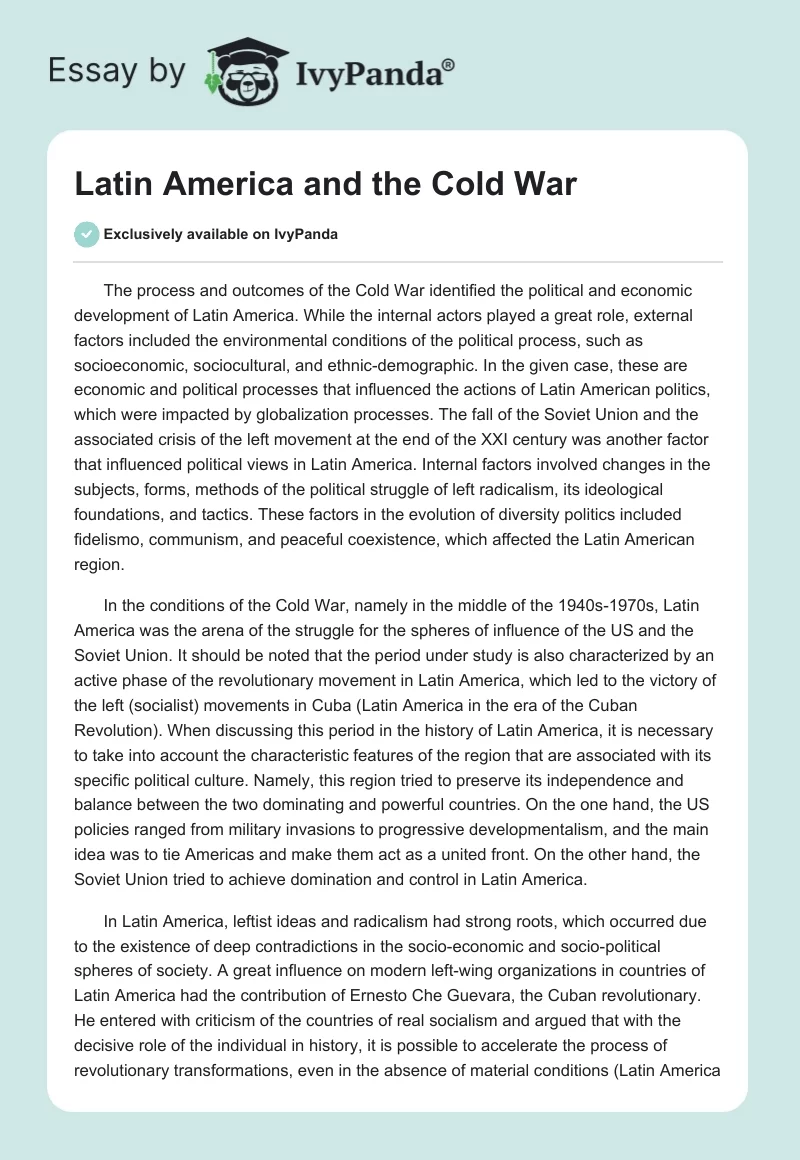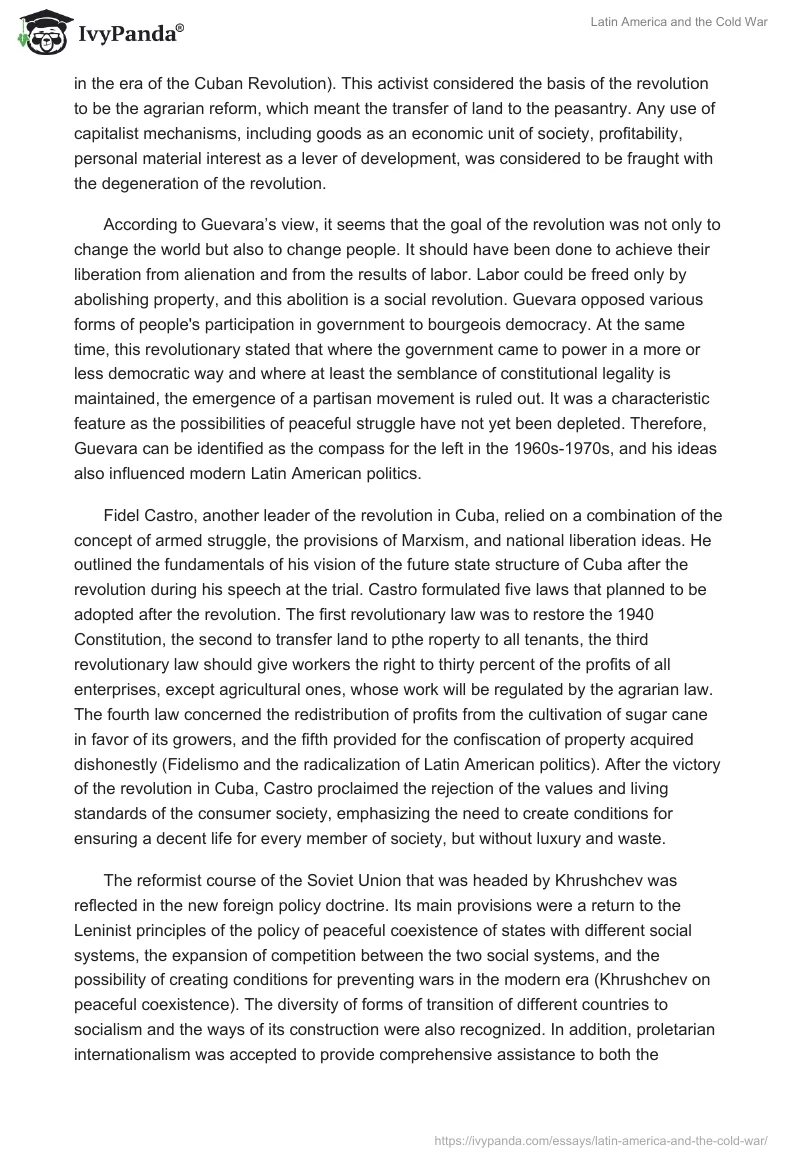The process and outcomes of the Cold War identified the political and economic development of Latin America. While the internal actors played a great role, external factors included the environmental conditions of the political process, such as socioeconomic, sociocultural, and ethnic-demographic. In the given case, these are economic and political processes that influenced the actions of Latin American politics, which were impacted by globalization processes. The fall of the Soviet Union and the associated crisis of the left movement at the end of the XXI century was another factor that influenced political views in Latin America. Internal factors involved changes in the subjects, forms, methods of the political struggle of left radicalism, its ideological foundations, and tactics. These factors in the evolution of diversity politics included fidelismo, communism, and peaceful coexistence, which affected the Latin American region.
In the conditions of the Cold War, namely in the middle of the 1940s-1970s, Latin America was the arena of the struggle for the spheres of influence of the US and the Soviet Union. It should be noted that the period under study is also characterized by an active phase of the revolutionary movement in Latin America, which led to the victory of the left (socialist) movements in Cuba (Latin America in the era of the Cuban Revolution). When discussing this period in the history of Latin America, it is necessary to take into account the characteristic features of the region that are associated with its specific political culture. Namely, this region tried to preserve its independence and balance between the two dominating and powerful countries. On the one hand, the US policies ranged from military invasions to progressive developmentalism, and the main idea was to tie Americas and make them act as a united front. On the other hand, the Soviet Union tried to achieve domination and control in Latin America.
In Latin America, leftist ideas and radicalism had strong roots, which occurred due to the existence of deep contradictions in the socio-economic and socio-political spheres of society. A great influence on modern left-wing organizations in countries of Latin America had the contribution of Ernesto Che Guevara, the Cuban revolutionary. He entered with criticism of the countries of real socialism and argued that with the decisive role of the individual in history, it is possible to accelerate the process of revolutionary transformations, even in the absence of material conditions (Latin America in the era of the Cuban Revolution). This activist considered the basis of the revolution to be the agrarian reform, which meant the transfer of land to the peasantry. Any use of capitalist mechanisms, including goods as an economic unit of society, profitability, personal material interest as a lever of development, was considered to be fraught with the degeneration of the revolution.
According to Guevara’s view, it seems that the goal of the revolution was not only to change the world but also to change people. It should have been done to achieve their liberation from alienation and from the results of labor. Labor could be freed only by abolishing property, and this abolition is a social revolution. Guevara opposed various forms of people’s participation in government to bourgeois democracy. At the same time, this revolutionary stated that where the government came to power in a more or less democratic way and where at least the semblance of constitutional legality is maintained, the emergence of a partisan movement is ruled out. It was a characteristic feature as the possibilities of peaceful struggle have not yet been depleted. Therefore, Guevara can be identified as the compass for the left in the 1960s-1970s, and his ideas also influenced modern Latin American politics.
Fidel Castro, another leader of the revolution in Cuba, relied on a combination of the concept of armed struggle, the provisions of Marxism, and national liberation ideas. He outlined the fundamentals of his vision of the future state structure of Cuba after the revolution during his speech at the trial. Castro formulated five laws that planned to be adopted after the revolution. The first revolutionary law was to restore the 1940 Constitution, the second to transfer land to pthe roperty to all tenants, the third revolutionary law should give workers the right to thirty percent of the profits of all enterprises, except agricultural ones, whose work will be regulated by the agrarian law. The fourth law concerned the redistribution of profits from the cultivation of sugar cane in favor of its growers, and the fifth provided for the confiscation of property acquired dishonestly (Fidelismo and the radicalization of Latin American politics). After the victory of the revolution in Cuba, Castro proclaimed the rejection of the values and living standards of the consumer society, emphasizing the need to create conditions for ensuring a decent life for every member of society, but without luxury and waste.
The reformist course of the Soviet Union that was headed by Khrushchev was reflected in the new foreign policy doctrine. Its main provisions were a return to the Leninist principles of the policy of peaceful coexistence of states with different social systems, the expansion of competition between the two social systems, and the possibility of creating conditions for preventing wars in the modern era (Khrushchev on peaceful coexistence). The diversity of forms of transition of different countries to socialism and the ways of its construction were also recognized. In addition, proletarian internationalism was accepted to provide comprehensive assistance to both the countries of the socialist side and the world communist and national liberation movement. According to Khrushchev, even when imperialism and bourgeois reaction create a military threat to the socialist countries or present humiliating demands that infringe on their sovereignty and dignity, the socialist countries should still make concessions and constantly adapt.
The main provisions of the concept of the Chilean Revolution and Conversations with Allende can be defined as criticism of the communist and reformist parties, as well as countries of real socialism and the concept of peaceful coexistence. From the position of this author, a peaceful path of revolution is impossible, and legal methods of political struggle are ineffective (Allende’s Chile). For Latin America, the only way to bring about revolutionary change is through guerrilla warfare. The guerrilla movement must be composed of professional revolutionaries and peasants. The mobile partisan column should replace both the party and the propaganda work with the population. In Latin America, the revolution was regarded as possible because the constant population growth exacerbated social problems.
To conclude, this paper discussed that were several political views on the changes in the world, with a focus on Latin America. Guevara proposed the importance of revolutionary transformations ann agrarian reform. In turn, Castro believed that the combination of Marxist and national liberation ideas is the best solution that should be implemented. According to Khrushchev, the strategy of a peaceful coexistence could provide more benefits due to its non-violent nature that contributed to avoiding war. Ultimately, Allende’s views about Chile criticized the concept of peaceful coexistence as it was seen as non-applicable in terms of the social and economic problems of Latin America.
References
Allende’s ChileFideliomo and the radicalization of Latin American politics, 41-59.
Khrushchev on peaceful coexistence, 160-163. Latin America in the era of the Cuban Revolution.


